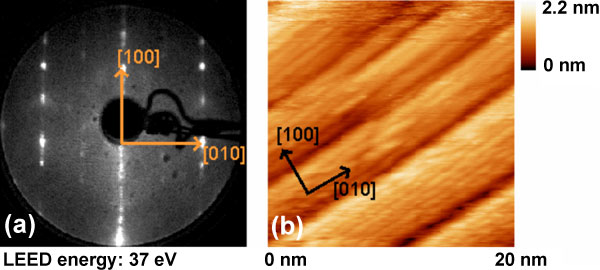- Home
- News
- Spotlight on Science
- Steps on Steps:...
Steps on Steps: The Nano-structure of a Vicinal Oxide Surface
11-07-2005
Grazing-incidence X-ray diffraction, combined with Low Energy Electron Diffraction (LEED) and Scanning Tunneling Microscopy (STM), shows that annealed SrTiO3 (103) surfaces exhibit regular nano-structures on two length-scales with shorter (~ 1.2 nm) ripples bunching to form longer (~ 7 nm) waves.
Share
The perovskite SrTiO3 (STO) is used as substrate for the epitaxy of giant magneto-resistance and high temperature superconductor (HTS) materials. STO also exhibits superconductivity, is catalytic and photo-active, and has potential applications such as gas-sensors and insulators with high dielectric constant for microelectronics. In all cases, the STO surface structure plays a crucial role.
Annealing up to 1000°C under ultra-high vacuum (UHV) produces clean and long range ordered STO surfaces as shown by the LEED image in Figure 1a. The visible spots represent Crystal Truncation Rods, indicative of a very smooth STO(103) surface. The STM image in Figure 1b shows modulations on two lengths scales in the [100] direction.
The SrTiO3(103) unit cells (cf. Figure 2 (a)) are responsible for the short-range modulation (1.2 nm) and (on average) six SrTiO3 (103) unit cells (Fig.2(b)) make up the longer range periodicity (7.2 nm) observed by STM along x-direction (or [100]). The resulting surface exhibits alternating, weakly polar terminations and the highly periodic ripples and waves appear to be stabilized by electrostatic forces. This is in contrast to usual self-organization on surfaces, commonly driven by strain, and represents a new paradigm in surface science.
Principal Publication and Authors
X. Torrelles (a), I. Joumard (b), TienLin Lee (b), O. Bikondoa (b) , J. Rius (a), and J. Zegenhagen (b)
(a) Institut de Ciència de Materials de Barcelona (C.S.I.C.), Bellaterra (Spain).
(b) ESRF





